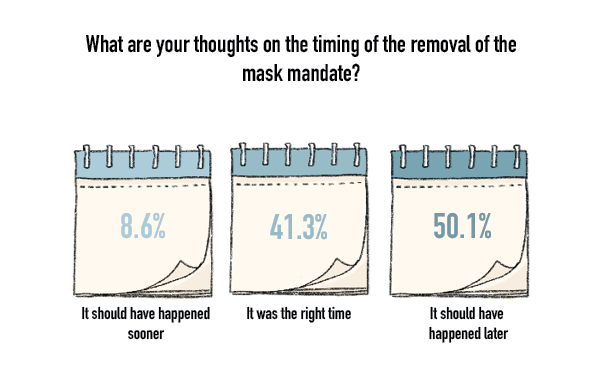Why masks should still be required
Everyone says that COVID-19 has drastically changed the world, yet people still refuse to accept that life will never go back to how it was before the pandemic. If we want to stop hearing the phrase ‘getting back to normal,’ then removing the mask mandate is not the solution. When something changes the world as substantially as the pandemic has, how are we supposed to revert to our old way of life?
One of the new norms we’ve adjusted to is masks. Yes, they are uncomfortable and inconvenient when you’re trying to talk to someone. Still, they’re necessary.
My mom works at Piedmont Athens Regional Hospital and has worked in person throughout the pandemic. When she comes home I hear the count of how many COVID patients have been admitted this week, and how many are on ventilators. I heard when both hospitals in Athens went on diversion because the ICUs and ERs were filled with COVID patients. It’s hard to hear things like this and to think that we’re fine to go ahead and lift mask mandates.
The first COVID-19 vaccine was released in the United States by Pfizer-Biotech on Dec. 11, 2020, and on Jun. 20, 2020, we were told that once you were fully vaccinated you no longer had to wear a mask. People were happy. We were finally getting through this pandemic after a year of isolation and personal hardships like losing family members, jobs or in-person school.
More recently many states and school districts have once again lifted mask mandates, including Clarke County School District. One contribution to this decision for many states and districts is the recent decline in cases, but cases and transmission rates will start to increase again once mandates are lifted.
“‘That gives us a head start on what we might expect and what we might be on the lookout for within our communities,’ Dr. Morgan added. ‘We may be at the tail-end of omicron but we may not yet be through the pandemic,” Dr. Jayne Morgan, in an article about Coronavirus found in wastewater said.

The most recent mutations of COVID-19 include Omicron and a new subvariant called BA.2 that has also been classified as a descendant of Omicron. Since this subvariant is still new to us, it’s hard to determine if it will make people sicker than the original strand of Omicron. However, it has already been determined to be more transmissible than the original Omicron strand by the World Health Organization.
“So far, studies show that BA.2 may be up to 30% more transmissible than the original Omicron, which means that without mitigation measures such as mask-wearing, handwashing and social distancing, the latest version of Omicron can spread rapidly in communities,” Alice Park wrote for TIME. Moreover, U.S. News reports that BA.2 accounted for 11% of coronavirus cases in America in the first week of March, a 5% increase from the previous week. So how safe are we without masks?
Some people believe that once you’ve gotten a variant of COVID-19, you have built up immunity to every other mutation that comes from the original variant. However, a study from the University of Illinois Urbana-Champaign found that antibody response differs between variants.
“The researchers studied the convergent antibodies’ ability to bind to several variants and found that they no longer bound to some. The finding has implications for the ability of new variants to reinfect people who contracted earlier versions of the virus,” professor Nicholas Wu said.
We can continue to complain and grumble about still living in a pandemic, but if we refuse the necessary measures to prevent its effects, will we ever reach the end?. If we aren’t willing to look at the data and realize we may hinder the progress we all want, then how are we ever going to move forward? Instead of complaining about it, take action. Instead of potentially creating another COVID-19 spike in schools without any boundaries to lessen the spread, enforce masks and social distancing measures. If not to allow advancement back to normal, then consider the families and elderly relatives that students go home to.
It’s our job to create a new normal by adapting to COVID-19 and the issues that stem from it. Eventually, normal may become a world where masks are no longer necessary, but we just simply are not there yet. It takes time to build a new reality.




